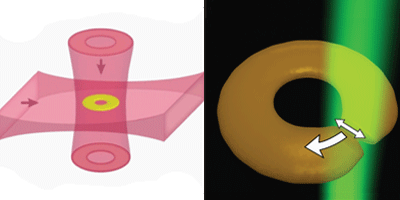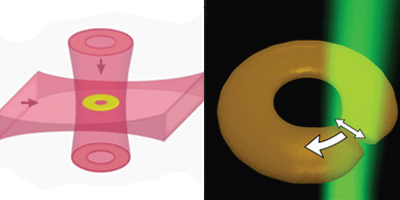Navigating with Cold Atoms
One of the most sensitive ways to detect magnetic fields is with a superconducting quantum interference device, or SQUID—a small loop of superconducting wire intercepted by one or more junctions. In Physical Review Letters, Kevin Wright and colleagues at the Joint Quantum Institute of the National Institute of Standards and Technology and the University of Maryland have now fabricated an analog to a SQUID by trapping a Bose-Einstein condensate (BEC) of atoms in a ring-shaped potential. This allows them to see the atomic wave function “slip” from one quantized state to another, and could be the basis of a new type of sensor.
In a superconducting loop, the phase of the wave function can only change by multiples of as it winds around the ring. The same holds true if a BEC is confined to a loop. In previous work, the researchers made a looplike circuit out of sodium atoms in a BEC by trapping the atoms in a torus-shaped potential created by two intersecting laser beams. Focusing a third laser at a segment along the torus created a barrier that depleted that region of atoms, similar to the effect of a junction in a SQUID.
Wright et al. are now able to make the BEC wave function jump from a state with zero phase change around the loop to states with and phase shifts by rotating the laser-induced barrier around the circuit at increasingly higher frequencies. Refinements of the atomic device could lead to a new type of rotation sensor, such as those used in spacecraft navigation. – Jessica Thomas





